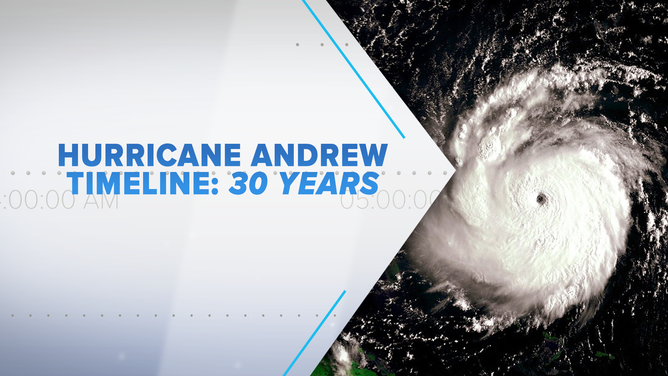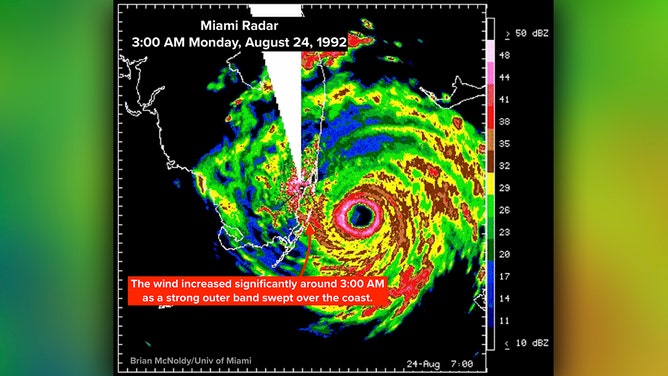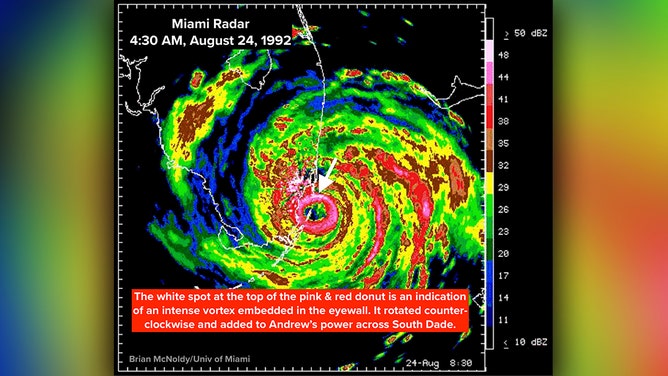Hurricane Andrew timeline: On this night, August 23, 1992
Those of us that went through the storm divide our lives into before Andrew and after Andrew. All because of what happened on this night in 1992.

30 years later, Bryan Norcross re-lives Hurricane Andrew that devastated South Florida with a timeline detailing what happened.
(FOX Weather)
Thirty years ago tonight – after midnight, early in the morning of Monday, August 24, 1992 – the world changed. Those of us that went through the storm divide our lives into before Andrew and after Andrew. All because of what happened on this night in 1992.
Hurricane Andrew moved through the Bahamas overnight and took dead aim on the southern part of Dade County, Florida. Today, the county is called Miami-Dade. The eyewall shrunk, the Gulf Stream provided fuel, and the atmospheric conditions came together to produce the epic event that Andrew became.
At 2:12 a.m., the radar clearly showed that Andrew was strengthening. I realized if that continued, people in South Dade were going to have to do everything possible to find safety in their homes. That's when the idea of getting the mattress off the bed came to me. I've often wondered why I never thought of it before.
In all my thinking and planning for a major hurricane, I hadn’t imagined a storm this extreme. It was that scary radar that forced me to dig deeper for a solution. I dredged up an idea of using a mattress for protection from a book called "The Florida Hurricane Disaster" by L.F. Reardon. After the 1926 Great Miami Hurricane, he wrote down his family’s story – how they rode out the epic hurricane in their home in Coral Gables including using a mattress for protection. I got a lot of credit, but L.F. Reardon had the mattress idea first.
At 3 a.m., the winds were starting to pick up outside the old WTVJ studios in downtown Miami. On the crude radar display we had then, I was not able to tell if we would be just inside or outside the northern edge of the donut of intense winds that was Andrew’s eyewall. I knew the winds would be stronger at the top of the skyscrapers, and the image of an air-conditioning unit flying off one of those buildings and through the roof of our old studio building flashed through my mind.

Brian McNoldy / University of Miami
Anchor Kelly Craig and I discussed the idea of moving to a safer location live on TV and on radio, which was the only way most people could hear us by that time. Millions had already lost power. I realized that it could be an important message to people who were wavering about moving to an interior hallway, a closet, or a small bathroom in their home. And it worked.
At 3:30 a.m., Kelly and I left the glossy news desk. The camera followed me into a storage area just off the studio that the floor crew had rigged with a monitor, microphones, and a phone. Tony Segreto, who had been the station’s sports anchor for decades but slid into the anchor chair like a glove, was already there. Soon Kelly Craig joined us, and that’s where the three of us rode out Hurricane Andrew.
Innumerable people later told me that that’s when they knew it was serious, and that realization caused them to take action. The move they made to a safer part of their house saved them from an even worse situation than they ended up encountering.
At 4 a.m., just as Andrew’s center was about to enter Biscayne Bay, a different color showed up in the top of the eyewall donut. In the image below, you see it as white. On the TV view I was looking at, it was bright red – just due to display differences. I was afraid this was very bad news. An intense vortex had formed in the eyewall, which looked like it would rotate over the suburban areas of South Dade boosting Andrew’s already extreme winds. After the storm, it was shown that this cell and a few others caused much of the extreme damage.

(Brian McNoldy / University of Miami)
READ THIS MORNING'S POST FOR THE HURRICANE ANDREW TIMELINE: AUGUST 23, 1992
At 4:38 a.m., the final scan of the Miami radar was recorded. The wind was gusting to over 150 mph at the roof level of the 12-story high rise where the National Hurricane Center was located in Coral Gables. About 15 minutes later, the giant radar dish and the huge golf ball-like dome that protected it, which sat on a tall pedestal above the roof, couldn’t take the extreme forces. A deep thud reverberated through the NHC building when the giant steel dish crashed onto the roof, scaring everybody inside. The dome shattered – pieces were found on the other side of the neighboring hotel.

(Brian McNoldy / University of Miami)
At the moment the radar failed, I was analyzing the scan live on TV. Suddenly, no more data was coming from the National Hurricane Center. I knew that somehow we had lost access to the radar. My initial thought was that the storm had cut the data feed, but about 20 minutes later we learned about the boom they felt in the Hurricane Center when the two-ton radar dish crashed onto the roof.
While this was going on, NHC forecaster Ed Rappaport was so focused on writing the 5:00 AM advisory he didn't remember the building shaking to its core. He, director Dr. Bob Sheets, and the entire staff were incredible that night and in the days after. They continued cranking out advisories as Andrew headed toward Louisiana, while many of them had damaged or destroyed homes in South Dade that had to be dealt with.
At 5:05 a.m., August 24, 1992, Hurricane Andrew made landfall in mainland Dade County at a place called Fender Point - a little spit of land just east-northeast of what was then called Homestead Air Force Base. The center of the eye hit a little less than 20 miles south of downtown Miami, but the corridor of extreme damage extended 13 miles to the north.
The eye shows up clearly two minutes after the official landfall on the new doppler radar out of Melbourne, Florida some 180 miles to the north.
The economic heart of Miami – South Beach, the Port of Miami, the Brickell Avenue banking district, the airport, and other critical buildings and infrastructure – missed the devastating winds of the eyewall by 5 to 10 miles. It was that close.
The worst of the storm only lasted about three hours, but for three hours, Mother Nature was at war with South Dade. Mother Nature won the physical war - the damage was so extreme that pictures don't do it justice. But the storm also proved how strong people can be – stronger than even they imagined before they were thrust into the hellish aftermath of Andrew.
On this day 30 years later, we mourn the 15 people who were lost in the storm that night. And we remember the shocking scenes that first light revealed – a world ripped to shreds and changed forever. But we also celebrate the amazing people of South Dade who climbed the mountain of recovery that was so high it's impossible to describe even today. Here's to you, the real heroes of the Great Hurricane of 1992.
Three decades ago, renowned hurricane specialist Bryan Norcross did a 23-hour marathon broadcast as Hurricane Andrew slammed into the Florida coast. His broadcast was the only one to stay on the air and many people’s only link to the outside world during the worst of the storm. He is credited with saving countless lives due to his life-saving advice. Now, 30 years later, Bryan will re-live the storm that devastated South Florida and look at the infrastructure changes that resulted. Watch The Wrath of Hurricane Andrew: Tragedy and Triumph on FOX Weather, premiering August 23rd and 24th at 10 P.M. EDT.
HOW TO WATCH FOX WEATHER ON TV
FOX Weather Hurricane Specialist Bryan Norcross has a podcast, Tracking the Tropics with Bryan Norcross, available now on FOX News Audio. You can get it on your device by clicking here.